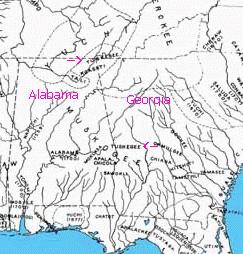
Click on above Map for larger view of Tuskegee areas in 1640.
Tuskegee: Meaning unknown, but apparently containing the Alabama term tĺska, "warrior."
Connection.óThe original Tuskegee language is unknown but it was probably affiliated with the Alabama, and hence with the southern branch of Muskhogeans.
Location.óThe later and best known location of this tribe was on the point of land between Coosa and Tallapoosa Rivers, but in 1685 part of them were on the Chattahoochee River near modern Columbus and the rest were on the upper Tennessee near Long Island.
Villages: None are known under any except the tribal name.
History.óIn 1540 De Soto passed through a town called Tasqui 2 days before he entered Coosa. In 1567 Vandera was informed that there were two places in this neighborhood near together called Tasqui and Tasquiqui, both of which probably belonged to the Tuskegee.
By the close of the seventeenth century the Tuskegee appear to have divided into two bands one of which Coxe (1705) places on an island in Tennessee River. This band continued to live on or near the Tennessee for a considerable period but in course of time settled among the Cherokee on the south side of Little Tennessee River, just above the mouth of Tellico, in the present Monroe County, Tenn. Sequoya lived there in his boyhood. Another place which retained this name, and was probably the site of an earlier settlement was on the north bank of Tennessee River, in a bend just below Chattanooga, while there was a Tuskegee Creek on the south bank of Little Tennessee River, north of Robbinsville, in Graham County, N. C. This band, or the greater part of it, was probably absorbed by the Cherokee.
A second body of Tuskegee moved to the location mentioned above where the Coosa and Tallapoosa Rivers come together. It is possible that they first established themselves among the Creek towns on the Ocmulgee, moved with them to the Chattahoochee in 1715 and finally to the point just indicated, for we have at least two documentary notices of Tuskegee at those points and they appear so situated on a number of maps. It is more likely that these were the Tuskegee who finally settled at the Coosa-Tallapoosa confluence than a third division of the tribe but the fact is not yet established. In 1717 the French fort called Fort Toulouse or the Alabama Fort was built close to this town and therefore it continued in the French interest as long as French rule lasted. After the Creek removal, the Tuskegee formed a town in the southeastern part of the Creek territories in Oklahoma, but at a later date part moved farther to the northwest and established themselves near Beggs.
Population.óThere are no figures for the Tuskegee division which remained on Tennessee River. The southern band had 10 men according to the estimate of 1750, but this is evidently too low. Later enumerations are 50 men in 1760, 40 in 1761, including those of Coosa Old Town, 25 in 1772 and 1792, 35 in 1799. The census of 1832-33 returned a population of 216 Indians and 25 Negro slaves.
Connection in which they have become noted.óThe name Tuskegee became applied locally to several places in eastern Tennessee and western North Carolina, and one in Creek County, Okla., but the most important place to receive it was Tuskeegee or Tuskegee, the county seat of Macon County, Ala. The Tuskegee Normal and Industrial Institute for colored people, located at this place, has, under the guidance of the late Booker T. Washington, made the name better known than any other association.
Tuskegee. A Creek division believed to be connected linguistically with the Alabama Indians. They removed to Oklahoma with the other Creeks and established themselves in the northwestern part of the allotted territory. (See Alabama.)
Taskigi, 3 towns occupied originally by Tuskegee Indians:
(1) on Little Tennessee River above the junction of the Tellico,
Monroe
County, Tenn.;
(2) on the north bank of Tennessee River just below Chattanooga,
Tenn.;
(3) perhaps on Tuskegee Creek of Little Tennessee River near
Robbinsville, Graham County, N.C.

The country immediately surrounding the later site of Chattanooga was occupied by a band of Tuskegee Indians, another Muskogean group that made the east Tennessee River region their home. Of like cultural and physical attributes, this group of Tuskegees most probably was absorbed into the predominant tribe of the region, the Cherokees.
The Tuskegee Indians were a civilized people that had their own customs and ways of life. They lived not to far from were the Tuskegee Army Airfield was constructed. The Creek nations along with the Tuskegee Indians were forced from their homeland during the white man's expansion in the 1830's and 1840's. Some of them escaped by traveling up north in the area around Oklahoma.
 Return to
Indigenous Peoples' Literature
Return to
Indigenous Peoples' Literature
Compiled by: Glenn Welker
This site has been accessed over 10,000,000 times since
February 8,
1996.